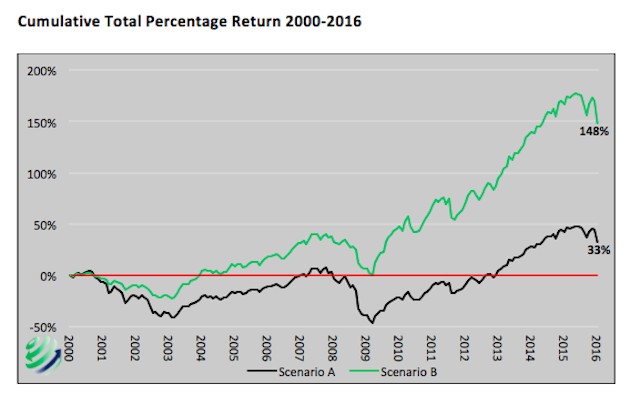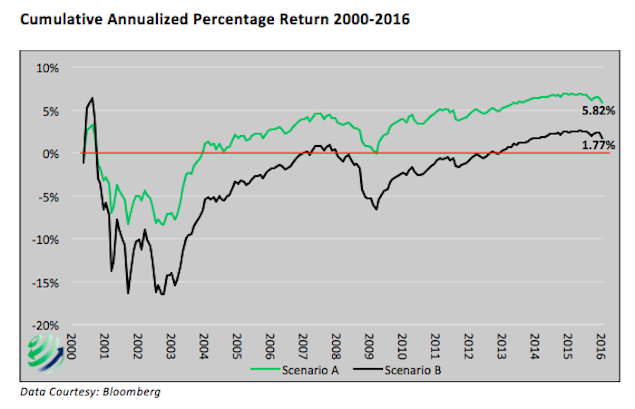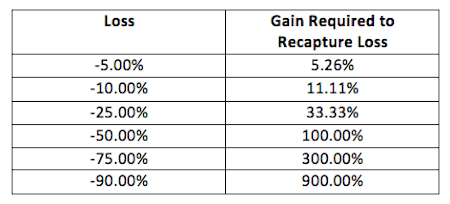“Most investors are primarily oriented toward return, how much they can make and pay little attention to risk, how much they can lose.” – Seth Klarman
Growing wealth through investing typically occurs over a long time horizon that includes many bullish and bearish market cycles. While making the most out of bull markets is important, it is equally important to avoid letting the inevitable bear markets reverse your progress. This article walks investment professionals through the under-appreciated benefits of limiting portfolio drawdowns and provides examples to help persuade clients to take a long term perspective on their wealth.
We start with two simple scenarios to highlight why limiting drawdowns is essential to building wealth. Scenario A is a buy and hold portfolio with a 100% allocation to the S&P 500 at all times. In scenario B the portfolio is also fully allocated to the S&P 500 except during the bear markets of 2000 (1/1/2000 – 3/31/2002) and 2008 (10/01/2007-04/30/09/. During those bear markets, the portfolio had a 50% allocation to the S&P 500 and the other half was in cash. At the troughs of the downturns portfolio B shifted back to a 100% equity position.
The graphs and table below show the cumulative total percentage return, cumulative annualized percentage return and other relevant performance statistics for both scenarios through mid-march (when this was originally published). The data is courtesy of Bloomberg.
No one can time the market perfectly in the manner described in this scenario, but the point of the analysis is to illustrate just how important it is to avoid large losses. There are two big takeaways from the data above. The most obvious is the significant difference in returns over the period. After two bull and bear market cycles, scenario B’s value grew at significantly faster clip than that of scenario A. It is Also worth noting that from 2000-2012, scenario A’s return was negative for all but 9 months. It was not until halfway through the current bull market that the losses of 2000 and 2008 were returned to the investor. Scenario B produced positive cumulative returns uninterrupted since 2004 despite the second large drawdown in 2008.
Compounding and the illusion of percentages are key factors that help explain why losses are hard to recover.
Compounding
The benefit of compounding is maximized when a portfolio is able to feed on itself or as Ben Franklin once said, “The money that money earns, earns money.” Portfolio losses take away from the ability to compound or leverage prior gains and force an investor to compound future growth from a lower dollar balance.
To highlight this point, suppose there are two investors A and B each with $100,000 portfolios. In year 1, A loses 15% and then goes on to earn 10% every year thereafter. B earns 10% every year. After 40 years, B will have amassed over $1 million more than A, solely because of A’s initial $15,000 setback. The difference between the value of A and B will continue to grow exponentially over time. In a hundred years, for instance, B will have over $300 million more than A. Compounding is an incredible resource to take advantage of. Even neglecting it for a year, as shown, can have a large effect on the future value of a portfolio.
Math
Equal percentage gains and percentage losses are not, in fact, equal. This may sound confusing, but again consider an investor with $100,000. If the investor loses 25%, the portfolio value is only $75,000. A 33% gain ($25,000/$75,000) is then needed to regain the original 25% loss. The table below shows the percentage gains required to offset percentage losses. As highlighted the gains necessary to recapture losses are manageable with limited losses but they get increasingly more challenging as percentage losses increase.
Summary
The hardest part in trying to limit losses is not necessarily timing the market, but imparting the wisdom of limiting losses upon your clients. To limit drawdowns advisors and their clients cannot fully embrace raging bull markets that are excessively valued. They must also have the iron stomach required to buy when everyone else is selling and assets are cheap. “Leaving money on the table” is not easy, but it is appropriate at certain times when the risk of losses outweigh the potential rewards. As your clients’ fiduciary, it is imperative that you help them understand they will not beat their neighbors’ portfolio every day, quarter or year. However, by employing a loss management system, the gains to their wealth will likely be much more fruitful than their neighbors’ over time.
We leave you with wisdom from Lance Roberts, www.Realinvestementadvice.com, who sums this up article up nicely:
“It is ALWAYS okay to miss out on an opportunity, as opportunities come along as often as a taxi-cab in New York City. However, it is IMPOSSIBLE to make up losses as you can never regain the time lost getting back to even”.
This article was originally published in WealthManagment.com.
More from Michael – Why Equities In 2016 Are Like A Bug Searching For A Windshield
Twitter: @michaellebowitz
Any opinions expressed herein are solely those of the author, and do not in any way represent the views or opinions of any other person or entity.












